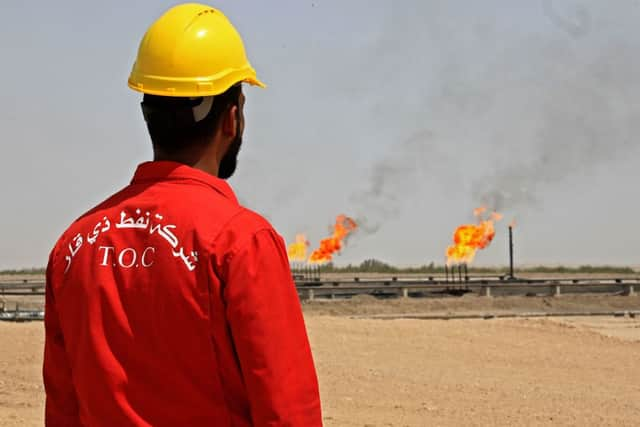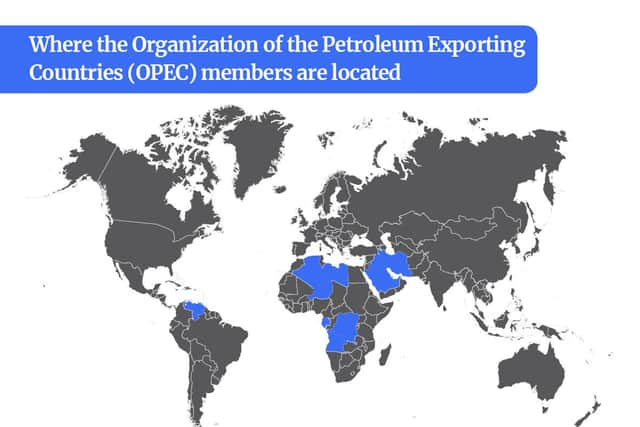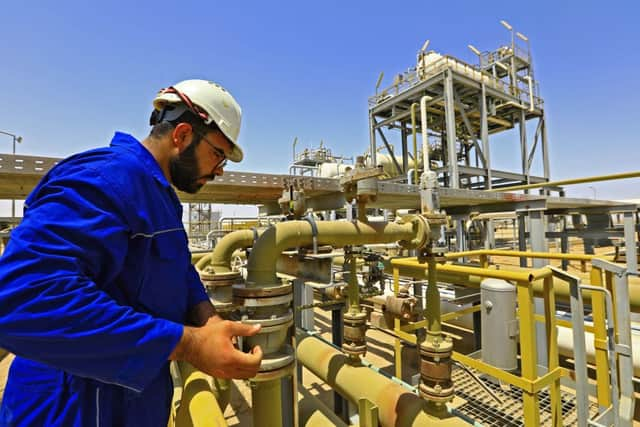What is OPEC? Member countries and influence on oil prices explained - as OPEC Plus announces production cut
and live on Freeview channel 276
Bad news could be on the horizon for UK drivers after countries that account for 40% of the world’s oil supply announced they would be cutting production.
Several members of the Organization of the Petroleum Exporting Countries, better known as OPEC, have said they are scaling back. Oil prices have been rising in light of the announcement, with the RAC warning any sustained increase is likely to be reflected in petrol prices at filling stations.
Advertisement
Hide AdAdvertisement
Hide AdIt all comes little more than a year since fuel prices rocketed in light of Russia’s invasion of Ukraine. As the world’s third largest oil producer, the country’s sudden pariah status in Europe led to a scramble for other supplies around the world and pushed prices to their highest levels since the 2008 Financial Crisis.
Pump prices have been declining ever since, although there has been some controversy over whether fuel retailers have been passing on reductions to consumers quickly enough. Any increase in the cost of fuel could mean inflation remains elevated for longer - something that would deepen the cost of living crisis.
So, what is OPEC - and who are its member states? Here’s everything you need to know.
What is OPEC?
OPEC is a group of 13 nations that produce and export oil. Together, they supply 30% of the world’s crude oil.
Advertisement
Hide AdAdvertisement
Hide AdThe organisation was founded in 1960 as part of a bid to essentially fix oil prices. Its members adjust their production levels up and down depending on the global picture in a bid to ensure prices are the best they can be, or sometimes to force countries to make political decisions in their favour.


At the time of its formation, the influence of colonial powers - including the UK and France - had weakened, while the founder countries were battling to wrest control of their resources from major fuel companies. It shot to international prominence in the 1973 oil crisis. A Saudi Arabian-led oil embargo of countries that had supported Israel during the Yom Kippur War - a short conflict that saw Israel defeat attacks by Egypt and Syria - led to a global price shock.
Although the principal target of the embargo was the US, which had grown to be reliant on Middle Eastern and South American oil as its own production had peaked, knock-on impacts were felt in the UK, where soaring oil prices fueled the inflation crisis the current cost of living crisis is often compared to.
While the war was ultimately won by Israel, OPEC’s political power had been underlined and has endured. Over the intervening decades, with globalisation leading to high demand for oil, it has remained a powerful force when it comes to the global economy.
Advertisement
Hide AdAdvertisement
Hide AdWho are the OPEC countries?
OPEC has 13 core member states. The five founding members were: Iran, Iraq, Kuwait, Saudi Arabia and Venezuela.
Qatar, Indonesia, Libya, the United Arab Emirates (UAE) and Algeria all joined the organisation in the 1960s, before Nigeria, Ecuador and Gabon became members in the 1970s. Subsequent additions include Angola in 2007, Equatorial Guinea in 2017 and the Republic of the Congo in 2018.


Over the last decade, three countries have quit OPEC. Indonesia left in 2016, before Qatar (2019) and Ecuador (2020) went their separate ways. Qatar’s departure was particularly contentious in the Middle East, with its decision to leave said to be as a result of Saudi Arabia’s blockade of the Gulf state.
In 2016, when oil prices were struggling, OPEC decided to form OPEC+ with another 10 globally significant oil producers. As well as widening the geographical spread of its membership, from Mexico to Malaysia, this new grouping also included Russia.
Advertisement
Hide AdAdvertisement
Hide AdOPEC Plus oil production cut explained
It is the OPEC+ group - which accounts for 40% of the world’s oil supply - that has announced it will scale back oil production by more than a million barrels of oil per day. The US has described the cut as inadvisable.
To put this in perspective, this figure is slightly more than the UK’s entire daily oil output in 2021 (934,000 barrels). It follows the announcement of a two million barrels per day cut in October 2022.


Saudi Arabia is cutting output by 500,000 barrels a day, while Iraq is reducing it by 211,000. The UAE, Kuwait, Algeria and Oman are also introducing cutbacks. These come after Russia announced it would be extending its own cut of 500,000 barrels a day until the end of 2023.
The only reasoning we have had from OPEC+ for its move has come from a Saudi energy ministry official, who told the official Saudi Press Agency that the move was "a precautionary measure aimed at supporting the stability of the oil market". But there are two key factors that could explain the move.
Advertisement
Hide AdAdvertisement
Hide AdFirst, with the global economy in a fragile state, the move may be an attempt to shore up prices ahead of a possible worldwide recession. During recessions, less oil tends to be consumed as businesses tend to scale back their operations. If OPEC was oversupplying the world with oil, it would crash the price of the fuel.
The second factor, for which there is very little evidence, is that OPEC has been influenced by Russia. The West has targeted the country’s key sources of income - oil and gas - in its bid to derail President Vladimir Putin’s war in Ukraine. While sanctions have generally had some degree of success, Moscow has been able to make up some of its lost revenue by exporting its resources to China and India.
Comment Guidelines
National World encourages reader discussion on our stories. User feedback, insights and back-and-forth exchanges add a rich layer of context to reporting. Please review our Community Guidelines before commenting.
